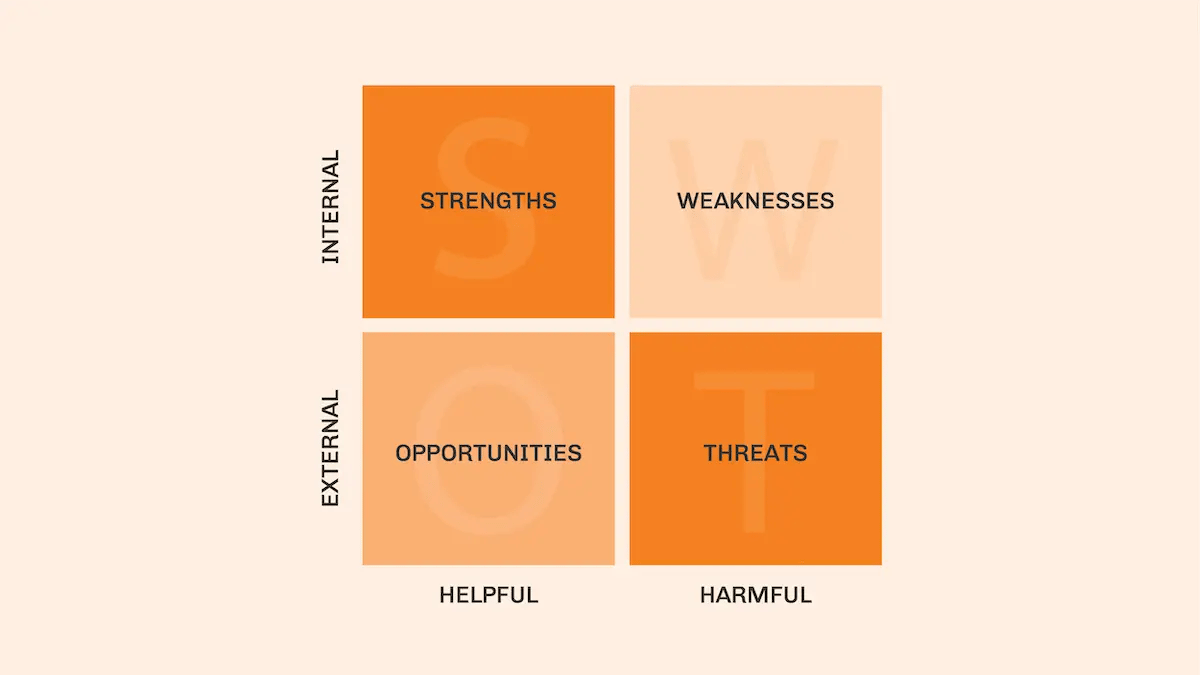SWOT analysis is a powerful acronym used in the marketing world that can help businesses grow their business. The goal of SWOT is to help organizations develop a full awareness of all of the factors involved in making business decisions.
SWOT (strengths, weaknesses, opportunities, threats) analysis should be performed before committing any sort of company action.
Ready to learn more about the SWOT marketing model and what it can do for you?
Marketing SWOT |
What is SWOT Analysis?
SWOT analysis is a planning model based on the following acronym:
- Strengths
- Weaknesses
- Opportunities
- Threats
This framework is an advanced strategic planning technique that is designed to help businesses assess where they are and bring in fresh perspectives and new ideas using a fact-based analysis.
It uses both internal and external data to guide businesses towards better strategies and away from strategies that don’t work.
At first, SWO analysis was used only to analyze businesses, now it’s used by governments, non-profits, investors, and entrepreneurs alike, as it has become one of the most versatile and highly-utilized analysis systems today.
What Are the Components of SWOT Analysis?
While SWOT analysis can be applied in different settings and situations, it always includes the same four categories and components
Strengths
This details what the organization excels at or what separates one business from the competition. This can be a strong brand identity or a loyal customer base, a unique product or service—whatever it may be. Understanding what these strengths are can help businesses use their results to attract new investors.
Weaknesses
Just like strengths, it’s also important to identify weaknesses within a business as these can stop an organization from performing at its top level and reaching its full potential. Weaknesses are areas where the business can and should improve to remain competitive. Weakness can be anything from high levels of debt or a lack of capital to supply chain issues.
Opportunities
The opportunities step of the SWOT process refers to a favorable external factor that may give organizations a competitive edge over the competition. This may be the opportunity to get into a new market, increase sales, or gain market share.
Threats
Threats refer to factors that have the potential to harm an organization. A threat can be anything from rising costs in materials to tight labor supply or even a negative environmental impact.
Typically, SWOT is presented in a four-quadrant table, providing a visual arrangement and a quick overview of the company’s position and provide a quick overview of all of the advantages and opportunities as well as threats and disadvantages that may impact the company.
All points should be detailed in this graph, even if they aren’t all of equal importance. Typically, the SWOT table is laid out with internal factors on the top row and external factors on the bottom row. Items on the left side of the table are meant to represent more favorable aspects of the company’s current position, while items on the right are more negative or concerning elements.

How Do You Perform a SWOT Analysis?
Here are the steps involved with performing a SWOT analysis, in general, the process will follow five detailed steps.
Step 1: Determine The Objective
SWOT analyses can be broad, but they tend to work best when the organization points out an objective from the beginning. So, instead of simply applying SWOT analysis as a whole to a brand, it’s best to focus on something like whether the existing Facebook marketing budget is working, or if it is the right time for the company to launch a new product.
An objective puts a lens on the process and guidance on what is hoped to be achieved at the end of the analysis. This is the most effective way to get real results from SWOT.
Step 2: Gather Resources
The SWOT analysis process will vary in every situation, which is why any company looking to perform this analysis will need different data sets. First, it’s important to understand what information the company has access to and what data limitations it potentially faces.
Data is important, but so is having the right personnel in the analysis. Gather a group of team members that represent different opinions and responsibilities within the brand. Broad sets of perspectives are more likely to create diverse contributions and opinions and a better overall collection of information to use in the analysis.
Step 3: Compile Ideas
With the right data and the right personnel insight in place, it’s time to start gathering and compiling ideas together. All of the personnel involved should start listing their ideas within each category.
- Internal Factors
What occurs within the company is a great source of information for both the “Strengths” category and the “Weaknesses.” Internal factors can be both tangible and intangible. This is the time to gather information on what the company is doing well and not so well.
- External Factors
What happens outside of the company is also important. External influences, such as monetary policies and market changes can create a list of opportunities and weaknesses. This is the time to ask about competitors and their market share as well as trends that are emerging in the marketplace.
Some companies refer to this process as “white-boarding” and just like with brainstorming there is no right or wrong idea.
Step 4: Refine Findings
With a giant compiled list of ideas in place, it’s time to start refining the list down. This allows the company to focus on the best ideas for improvement and on the largest risks that may be threatening the company. While there will be some debate and back and forth, this is an important step to narrow down the focus of the analysis moving forward.
Step 5: Develop the Strategy
The final step in the analysis process is to create a strategy and real action steps including strengths, weaknesses, opportunities, and threats. The analysis team can take the refined elements of their list and start developing a strategy to get make changes and get the results needed for company-wide improvement.
Conclusion
SWOT is an effective and efficient model for analyzing information. If companies can utilize this framework appropriately, they will find a more organized method of handling their marketing initiatives moving forward.
 You've made it this far and you've learned so much. Congratulations!
You've made it this far and you've learned so much. Congratulations!
If you're looking to learn more about marketing or Ecommerce in general, feel free to reach out to us at: solutions@undigital.com
You May Also Like
These Related Stories

How to Create an Ecommerce Marketing Plan

Unboxing Marketing 101: Understanding the Basics


